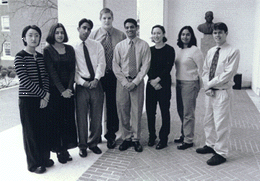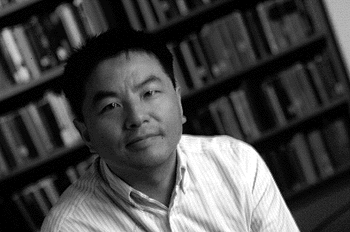
 Foreign Affairs Symposium
begins
Foreign Affairs Symposium
begins
One day last May undergraduates Jay Suresh and Hari Chandra found
themselves at the entrance to the Organization of American States
in Washington. The two had gone to the nation's capital not to
sight-see but rather with a specific agenda: to recruit speakers
for the 1999 Johns Hopkins University
Symposium on Foreign
Affairs. As co-directors of the symposium, Suresh and
Chandra were on a mission to assemble a first-rate panel of
former heads of state and experts on world affairs.
Their quest this day was Cesar Gaviria,
secretary general of OAS and former president of Colombia. They
had come unannounced, and when they approached the entrance, they
handed the security guard an invitation to the symposium, which
they had brought with them. Both Suresh and Chandra thought that
might be the end of the encounter, but to their surprise they
were told to wait. Sometime later the guard told them that
Gaviria's chief of staff had to make some phone calls and they
would have to continue to be patient. Later still, a call came
into the guard house. It seems their patience had paid off.
Full story...
 Statistician stays ahead of the
curve
Statistician stays ahead of the
curve
Health researchers wondered whether African infants grew more
slowly if their mothers consumed insufficient vitamin A during
pregnancy. Drug addiction experts wanted to see whether a new
medication would ease withdrawal pain. Researchers studying men's
health needed to know how HIV infection affects immune cell
counts over a period of years.
To help make sense of the raw data they
collected, scientists in each of these studies called in Colin
Wu, a biostatistics expert from the School of
Engineering. Wu, an associate professor of mathematical sciences, uses a
relatively new form of data analysis called curve estimation to
produce clearer pictures of how health changes over time.
Standard statistical methods provide just a
snapshot of health conditions at a single point in time. In the
growth study, for example, standard methods could have told
researchers the average weight, exactly two years after birth, of
children born to HIV-positive, vitamin A-deficient mothers. But
Wu's technique yielded a curve that spanned the length of a
project. It let researchers compare average growth figures for
the children two months after birth, 23 months after or anywhere
in between.
Full story...
| [ The Gazette | Search | About the Gazette | Send us Email ] |
The Gazette
 The Johns Hopkins University
The Johns Hopkins University
 Suite 100
Suite 100

3003 North Charles Street
 Baltimore, Maryland 21218
Baltimore, Maryland 21218
 (410) 516-8514
(410) 516-8514  gazette@resource.ca.jhu.edu.
gazette@resource.ca.jhu.edu.
